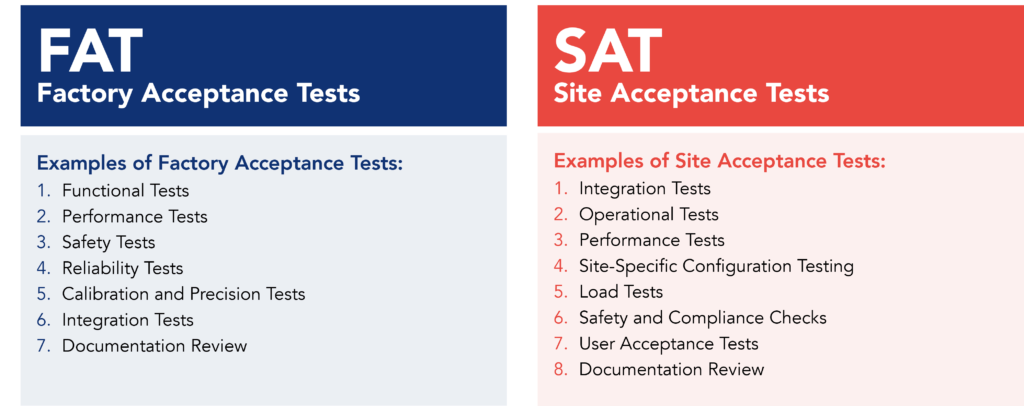Efficient capital project management is crucial for successful initiatives involving significant investments. In this perspective, Factory Acceptance Tests (FAT) and Site Acceptance Tests (SAT) play a fundamental role in ensuring equipment and systems’ quality, reliability, and compliance.
This article explores the importance of these tests in capital projects, highlighting how the factory and on-site testing process ensures that the equipment meets specifications and contributes to mitigating risks and securing efficient operation throughout the equipment’s lifespan. By examining the relationship between FAT, SAT, and excellence in capital projects, we can better understand how these practices are essential for delivering consistent, high-quality results in complex and dynamic industrial environments.
What is a Factory Acceptance Test (FAT)?
A Factory Acceptance Test (FAT) is crucial in capital projects’ lifecycle, playing a vital role in industrial equipment quality and compliance. This test is carried out before the equipment is fitted on-site and is designed to validate whether the manufactured equipment meets the pre-defined technical and functional specifications.
Definition and Objectives of Factory Acceptance Test (FAT)
FAT is a systematic procedure in which equipment, systems, or components undergo tests and checks within the manufacturer’s environment. The primary objective is to ensure the products meet the requirements set by the client, industrial standards, and project specifications. By conducting the FAT, suppliers can demonstrate the equipment is ready for the project’s next phase before being dispatched to the site.
Examples of tests include functional tests, performance tests, safety tests, reliability tests, calibration and accuracy tests, integration tests, and documentation reviews.
Factory Acceptance Test Procedures
The FAT process generally follows a structured procedure:
- Planning: Clear definition of acceptance criteria, elaboration of the test plan, and documentation preparation.
- Test Execution: Conducting performance, functionality, safety tests, and compliance with technical specifications.
- Documentation: Detailed recording of all tests, results, and any deviations identified.
- Review and Approval: Analysis of the client’s and other stakeholders’ results, followed by approval or adjustments.
The planning referred to in Step 1 plays a crucial role, providing an organized framework for executing test procedures and establishing clear acceptance criteria. This plan acts as a guide for the test team, ensuring consistency. This document covers various essential aspects and comprises:
- Test Objectives: A clear statement of the specific objectives for each test, aligned with the client’s requirements and the project’s goals.
- Test Scope: Defining the scope and boundaries of the test and determining which elements of the equipment or system will be evaluated.
- Test Methods: Describing the specific methods and approaches to conduct each test, ensuring consistency and standardization.
- Acceptance Criteria: Setting clear criteria defining whether a test is successful provides an objective basis for evaluating the results.
- Test Equipment: A comprehensive listing of the equipment and tools required for each test, ensuring the team is adequately prepared.
- Timelines: Allocating time for each test, including detailed schedules, to ensure timely completion of all testing activities.
By compiling these elements into the Test Plan, the test team and other stakeholders have a comprehensive resource that efficiently guides the execution of the FAT. This document not only promotes clarity and consistency in the process but also significantly contributes to the overall effectiveness of the FAT, ensuring that each test is conducted rigorously and in alignment with the project requirements.
Role of the Factory Acceptance Tests in Capital Projects
FATs play a significant role in capital projects for several reasons:
- Quality Assurance: FATs are essential for ensuring the equipment meets the required quality standards, providing confidence in the equipment’s effectiveness.
- Early Identification of Problems: Any defects or deviations from specifications can be identified and corrected before on-site installation, reducing costs and delays.
- Risk Mitigation: By conducting comprehensive tests in the manufacturing phase, risks associated with inadequate on-site performance are significantly reduced.
- Operational Efficiency: Equipment that undergoes a successful FAT is more likely to operate efficiently from the start, contributing to the project’s overall efficiency.
Therefore, the Factory Acceptance Test is more than just a verification procedure; it is vital in delivering successful capital projects, ensuring that the equipment meets the client’s expectations and operates as planned throughout its lifespan.
What is a Site Acceptance Test (SAT)?
The Site Acceptance Test (SAT) is an essential phase in capital projects, indicating the transition between manufacturing and implementing equipment or systems in the client’s specific environment. This test ensures the components previously subjected to the Factory Acceptance Test (FAT) continue to meet the specifications and requirements when installed at the project site.
Definition and Objectives of the Site Acceptance Test (SAT)
The SAT is a set of procedures and tests conducted at the installation site to check whether the equipment or system operates as planned in its final environment. Unlike the FAT, which occurs at the manufacturer’s facilities, the SAT simulates the actual operating conditions, identifying potential site-specific challenges that may impact performance.
Examples of tests include integration, operational, load, and stress tests, safety and compliance checks, user acceptance, performance assessments, and documentation reviews.
Site Acceptance Test Procedure
The SAT is carried out through a series of steps:
- Planning: Clearly define the acceptance criteria, develop the test plan, and prepare the required documentation.
- Site Preparation: Adapting the site environment to reflect operational conditions, including electrical installations, connections, and other relevant parameters.
- Equipment Installation: installing and configuring the equipment on site, following the specifications and guidelines of the project.
- Test Execution: Conducting specific tests, replicating the expected operational conditions, and confirming if the equipment meets the established acceptance criteria.
- Documentation: Detailed recording of all tests, results, and any deviations identified.
- Review and Approval: Analysis of the results, followed by approval or request for adjustments.
As with the FAT, the Test Plan for the SAT plays a crucial role, providing an organized framework for executing test procedures and establishing clear acceptance criteria. The plan is organized similarly to what is outlined in the FAT.
Role of Site Acceptance Test in Capital Projects
The SAT is an essential phase in capital projects for several reasons:
- Validation of Performance in the Actual Environment: The SAT validates the performance of the equipment under the exact conditions in which it will be used, reducing the risks associated with potential incompatibilities.
- Identification of On-site Problems: Potential site-specific challenges, such as space constraints or environmental requirements, are identified and addressed during the SAT.
- Successful Integration: The SAT ensures that the equipment effectively integrates with the surrounding environment, preventing potential operational disruptions.
- Continued Compliance with Requirements: It validates whether the equipment still satisfies the specifications and acceptance criteria established, even after moving to the installation site.
- Involvement of End Users: Involves end users or operators in the testing phase. This approach assesses the equipment’s ease of use, promoting operator satisfaction and efficient utilization.
Upon completing the Site Acceptance Test, the project team can be confident that the equipment can operate effectively in the client’s environment. This ensures sustained proper functioning and successful completion of the capital project.

Collaboration and Communication in FAT and SAT
Communication plays a central role in the success of acceptance tests, aligning expectations, clarifying requirements, and ensuring that all parties are synchronized. Regular information exchange during the FAT and SAT phases is vital for mitigating potential challenges and ensuring the client’s expectations, quality standards, and project specifications are understood and effectively met.
Transparent communication reduces the risk of misunderstandings, allowing project teams, suppliers, and end-users to be on the same page. This alignment contributes to the overall efficiency of the testing process, minimizing rework and ensuring a smooth transition between the manufacturing, installation, and operational phases.
Conclusion
Factory Acceptance Tests (FAT) and Site Acceptance Tests (SAT) play significant roles in capital projects. Beyond ensuring compliance with technical specifications, these tests contribute considerably to risk mitigation, early problem identification, and operational efficiency throughout the equipment’s lifespan.
Looking to the future, technological advancements, such as digitalization and automation, will surely make these tests more efficient and adaptable. Ultimately, the importance of FAT and SAT goes beyond technical compliance, ensuring consistent, high-quality results in capital projects.
Still have questions about Factory and Site Acceptance Tests?
When should the FAT and SAT planning workshops be held?
The planning workshops for the Factory Acceptance Test (FAT) and Site Acceptance Test (SAT) are typically scheduled during the project lifecycle’s Procurement, Implementation & Capability Building phase.
Who should attend the FAT and SAT planning workshops?
Planning workshops for the Factory and Site Acceptance Test should include a multifunctional team comprising critical representatives from different areas. The recommended participants may vary depending on the specific nature of the project but generally include project managers, project engineers, quality managers, testing specialists, end-users or operators, safety experts, and suppliers.
See more on Capital Project Excellence
Find out more about improving this business area
